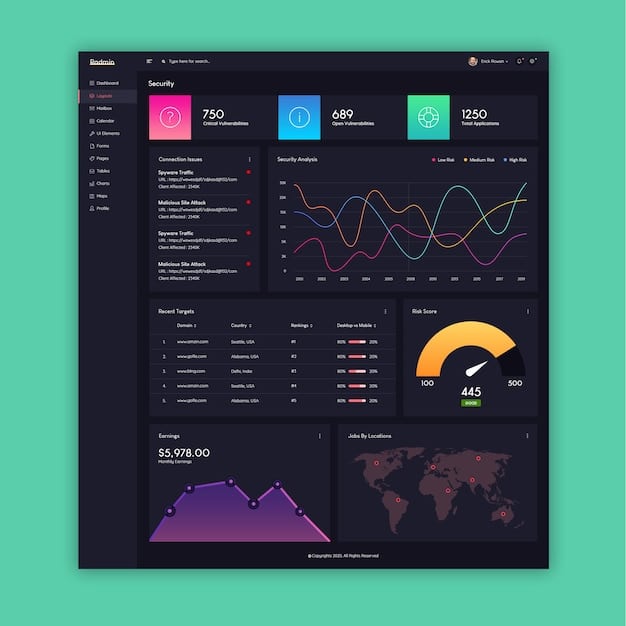Data-Driven Business Management: Boost Performance with Analytics

Data-driven business management leverages analytics to inform strategic decisions, optimize operations, and enhance overall performance by tracking key metrics, identifying trends, and predicting future outcomes.
In today’s competitive landscape, businesses are constantly seeking ways to improve performance and gain a competitive edge. One of the most effective strategies is data-driven business management, which involves using analytics to inform strategic decisions, optimize operations, and enhance overall performance.
Understanding Data-Driven Business Management
Data-driven business management is more than just collecting data; it’s about transforming that data into actionable insights. By leveraging analytics, businesses can make informed decisions, optimize processes, and ultimately improve their bottom line.
It’s the key to staying competitive and relevant in today’s dynamic market.
What is Data-Driven Decision Making?
Data-driven decision making refers to the process of using data—rather than intuition or gut feelings—to guide business strategies. This involves collecting relevant data, analyzing it, and then using the insights derived to make informed decisions.
This strategy ensures that decisions are grounded in evidence, leading to more predictable and successful outcomes.
Benefits of Data-Driven Management
Implementing data-driven management offers many benefits. From improved efficiency to better customer understanding, incorporating analytics into decision-making can transform how a business operates.
- Improved Efficiency: Data analytics can identify bottlenecks and inefficiencies in business processes, allowing for targeted improvements.
- Better Customer Understanding: By analyzing customer data, businesses can gain insights into their preferences, behaviors, and needs, facilitating personalized services and marketing strategies.
- Enhanced Decision Making: Making decisions based on data rather than assumptions reduces risk and increases the likelihood of success.
- Increased Competitiveness: Data-driven businesses are better positioned to adapt to market changes and outperform competitors.
Data-driven management provides a robust framework for achieving sustainable growth and success.
Collecting the Right Data
The foundation of data-driven business management lies in collecting the right data. Without relevant and accurate data, analytics become meaningless.
Understanding what data to collect and how to collect it is crucial for generating meaningful insights.
Identifying Key Performance Indicators (KPIs)
KPIs are quantifiable metrics that measure the performance of a business against its strategic goals. Identifying the right KPIs is essential for tracking progress and making informed adjustments.
Common KPIs include revenue growth, customer acquisition cost, and customer satisfaction score.
Data Sources
Data can come from numerous sources, both internal and external. Common internal sources include sales data, marketing data, and operational data. External sources might include market research reports, social media analytics, and competitor data.
- Customer Relationship Management (CRM) Systems: These systems store customer data, including interactions, preferences, and purchase history.
- Web Analytics Platforms: Tools like Google Analytics provide insights into website traffic, user behavior, and conversion rates.
- Social Media Analytics: Platforms like Facebook Insights and Twitter Analytics offer data on social media engagement and audience demographics.
By tapping into these sources, businesses can gather a comprehensive view of their operations and market environment.
Ensuring Data Quality
Data quality is critical to the success of any data-driven initiative. Inaccurate or incomplete data can lead to flawed analysis and poor decision-making.
Businesses must implement data governance policies and invest in data cleansing processes to ensure data accuracy and reliability.

Analyzing Data for Insights
Once the data has been collected, the next step is to analyze it to extract meaningful insights. This involves using various analytical techniques and tools to identify patterns, trends, and anomalies.
The insights gained can then be used to inform strategic decisions and improve business performance.
Data Analysis Techniques
There are several data analysis techniques that businesses can use, depending on the type of data and the specific questions they are trying to answer.
These techniques range from simple descriptive statistics to more advanced predictive modeling.
Data Visualization Tools
Data visualization tools play a crucial role in making data understandable and actionable. These tools create charts, graphs, and other visual representations of data that help identify trends and patterns.
- Tableau: A powerful data visualization tool that allows users to create interactive dashboards and reports.
- Power BI: Microsoft’s data visualization tool that integrates seamlessly with other Microsoft products.
- Google Data Studio: A free data visualization tool that connects to a variety of data sources.
These tools can transform raw data into clear, compelling visuals that drive decision-making.
Using data visualization tools enhances understanding and promotes data-driven discussions.
Interpreting Results
Interpreting the results of data analysis requires critical thinking and business acumen. It’s not enough to simply identify patterns; businesses must also understand the context behind the data and what it means for their operations.
Consider factors such as market trends, competitor activities, and customer feedback to gain a comprehensive understanding of the insights.
Implementing Data-Driven Strategies
With data insights in hand, the next crucial step is to implement data-driven strategies. This involves translating insights into actionable plans and integrating them into daily operations.
Successfully executing data-driven strategies can lead to significant improvements in business performance and competitive advantage.
Strategic Planning
Data-driven strategic planning ensures that business goals are aligned with data insights. By using data to inform the strategic direction, companies can make more accurate predictions and adapt to market changes effectively.
This approach reduces risk and increases the likelihood of achieving strategic objectives.
Operational Improvements
Data can be used to optimize various operational processes, from supply chain management to customer service. By identifying bottlenecks and inefficiencies, businesses can implement targeted improvements that enhance productivity and reduce costs.
- Supply Chain Optimization: Using data to predict demand and optimize inventory levels.
- Customer Service Enhancement: Analyzing customer interactions to identify areas for improvement in service delivery.
- Marketing Campaign Optimization: Tracking the performance of marketing campaigns to refine targeting and messaging.
These operational improvements can lead to significant gains in efficiency and profitability.
Performance Monitoring
Continuous performance monitoring is essential to ensure that data-driven strategies are delivering the desired results. By tracking KPIs and regularly analyzing data, businesses can identify areas that need adjustment and make timely corrections.
Regular monitoring helps maintain alignment with strategic goals and ensures continuous improvement.
Building a Data-Driven Culture
Establishing a data-driven culture is essential for long-term success. This involves creating an environment where data is valued, accessible, and used throughout the organization.
Fostering a data-driven culture requires leadership commitment, employee training, and the right technology infrastructure.
Leadership Commitment
Leadership must champion the use of data in decision making. This involves setting clear expectations, providing resources for data initiatives, and recognizing and rewarding data-driven successes.
When leaders prioritize data, it sends a strong message throughout the organization.
Employee Training
Employees need to be trained on how to collect, analyze, and interpret data. This includes providing training on data analysis tools, data visualization techniques, and data governance policies.

- Data Literacy Programs: Offering courses and workshops to improve employees’ understanding of data concepts.
- Tool Training: Providing hands-on training on data analysis and visualization tools.
- Data Governance Training: Educating employees on data policies and best practices for data management.
Investing in employee training builds a skilled workforce capable of leveraging data effectively.
Technology Infrastructure
Having the right technology infrastructure is crucial for supporting data-driven initiatives. This includes investing in data storage solutions, data analysis tools, and data visualization platforms.
A robust technology infrastructure ensures that data is accessible, reliable, and easy to use.
Overcoming Challenges in Data-Driven Management
While data-driven business management offers tremendous benefits, it also presents several challenges. Overcoming these challenges is essential for realizing the full potential of data in improving business performance.
Addressing issues such as data privacy, resistance to change, and talent gaps can pave the way for successful data-driven transformation.
Data Privacy and Security
Data privacy and security are paramount concerns in today’s digital age. Businesses must comply with data privacy regulations, such as GDPR and CCPA, and implement robust security measures to protect sensitive data from unauthorized access.
Prioritizing data privacy builds trust with customers and protects the company’s reputation.
Resistance to Change
Implementing a data-driven culture can face resistance from employees who are accustomed to making decisions based on intuition or experience. Overcoming this resistance requires effective communication, training, and demonstrating the benefits of data-driven decision making.
- Communication: Clearly articulate the benefits of data-driven decision making and how it will improve business outcomes.
- Pilot Projects: Start with small-scale data projects to demonstrate the value of data in a tangible way.
- Incentives: Recognize and reward employees who embrace data-driven approaches.
Addressing resistance to change ensures the successful adoption of data-driven practices.
Talent Gaps
A shortage of skilled data analysts, data scientists, and data engineers can hinder data-driven initiatives. Businesses must invest in training programs and recruitment efforts to fill these talent gaps.
Building a skilled data team is crucial for driving insights and implementing data-driven strategies effectively.
| Key Point | Brief Description |
|---|---|
| 📊 Data Collection | Gather relevant data from various sources like CRM and web analytics. |
| 📈 Data Analysis | Use techniques and tools to uncover patterns and trends in the data. |
| 🎯 Strategy Implementation | Turn insights into actionable plans, aligning with business goals. |
| 🏢 Culture Building | Foster an environment where data is valued and utilized across the org. |
Frequently Asked Questions (FAQ)
Data-driven business management refers to using data and analytics to make informed decisions, optimize business processes, and improve overall performance. It replaces intuition-based strategies with evidence-based practices.
Data quality is crucial because inaccurate data leads to flawed analyses and poor decisions. Ensuring data is accurate, complete, and reliable is essential for effective data-driven management.
Data visualization tools transform raw data into charts, graphs, and other visuals, making it easier to identify patterns, trends, and insights. This clarity leads to quicker and more effective decision-making.
Common KPIs include revenue growth, customer acquisition cost (CAC), customer retention rate, customer satisfaction score (CSAT), and employee productivity. These metrics help track performance and make data-informed adjustments.
Building a data-driven culture involves leadership commitment, employee training, and the right technology. Leaders must champion data use, train employees on data analytics, and invest in robust data infrastructure.
Conclusion
In conclusion, embracing data-driven business management is essential for any organization looking to thrive in today’s competitive environment. By leveraging analytics to inform strategic decisions, optimize operations, and foster a data-driven culture, businesses can unlock new levels of performance and achieve sustainable success. From identifying key metrics to implementing robust monitoring systems, the path to data-driven excellence is paved with informed choices and continuous improvement.





